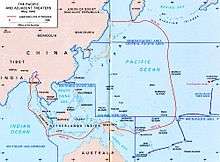South Pacific Area

The South Pacific Area (SOPAC) was a multinational U.S.-led military command active during World War II. It was a part of the U.S. Pacific Ocean Areas under Admiral Chester Nimitz.
Instructions to the senior U.S. Army officer of the command, dated 7 July 1942, said:[1]
"The establishment of the Pacific Ocean Area as an area of United States strategical responsibility under the command of the Commander-in-Chief, U.S. Pacific Fleet, became effective on May 8, 1942. The Commander-in-Chief, U.S. Pacific Fleet, has been designated the "Commander-in-Chief, Pacific Ocean Area". Under the Commander-in-Chief, Pacific Ocean Area, a U.S. Naval officer has been designated as "Commander, South Pacific Area". The South Pacific Force under COMSOPAC include the following:
- 1. All base and local defense forces (ground, naval and air) now assigned or to be assigned to forces in the South Pacific Area. The New Zealand Chiefs of Staff are responsible for the land defense of New Zealand, subject to such strategic decisions affecting this responsibility as may be made by the Commander-in-Chief, Pacific Fleet, for the conduct of naval operations in the Pacific Ocean Areas.
- 2. Assigned New Zealand, Free French, Dutch and other United Nations Naval forces.
- 3. Such fleet types and aircraft as may be assigned by the Commander-in-Chief, U.S. Pacific Fleet."
In July 1942 the South Pacific Area, under Admiral Ghormley, superseded by Admiral William Halsey Jr. from 16 October, comprised four commands: Amphibious Forces, South Pacific (AmphibForSoPac), under Admiral Richmond K. Turner, South Pacific Naval Forces under Admiral Ghormley, U.S. Army Forces South Pacific under Major General Millard Harmon, and South Pacific Air Forces under Admiral John S. McCain, Sr..[2] At a later stage Transport Group, South Pacific (TransGrpSoPac) was added to the organisation.
The organisation's first major battle was the Battle of Guadalcanal. Admiral Ghormley's Operations Order 1-42 established two task forces, Task Force 61 and Task Force 63, to carry the operation out.
On September 20, 1942, six weeks after the first American amphibious operation of the war got underway at Guadalcanal, Vice Admiral Aubrey Fitch assumed command of Aircraft, South Pacific Force (AirSoPac). Not a desk-bound admiral, he carried out numerous, hazardous flights into the combat zones, inspecting air activities and bases for projected operations. For these, he received a Distinguished Flying Cross. Under Fitch's command, AirSoPac—ultimately encompassing not only Navy but Army, Marine Corps, and Royal New Zealand Air Force air units—achieved great success in aiding the Allied campaign in the South Pacific Area.
Commander, Aircraft, Solomons (ComAirSols), directed the combat operations of all land-based air in the Solomons during CARTWHEEL, under the direction of AirSoPac.[3] Rear Admiral Charles P. Mason was the first officer to hold the title ComAirSols; he assumed command on 15 February 1943 at Guadalcanal. Actually, Mason took over a going concern, as he relieved Brigadier General Francis P. Mulcahy, who had controlled all aircraft stationed at the island during the final phase of its defense. Mulcahy, who became Mason's chief of staff, was also Commanding General, 2d Marine Aircraft Wing. The fact that a general headed the staff of an admiral is perhaps the best indication of the multiservice nature of AirSols operations.
Vice Admiral Finch retained two areas of flight operations under his direct control; sea search by long range Navy patrol planes and Army bombers, and transport operations by South Pacific Combat Air Transport Command (SCAT). Throughout its long and useful life (November 1942-February 1945), SCAT's complement of Marine and Army transports was headed by MAG-25's commanding officer. SCAT's operations area moved northward with the fighting during 1943, and by August's end, all regularly scheduled flights in SoPac's rear areas were being handled by the Naval Air Transport Service (NATS).
Commanders, South Pacific Area
- Vice Admiral Robert L. Ghormley (19 June–18 October 1942)
- Vice Adm./Adm. William Halsey, Jr. (18 October 1942–15 June 1944)
- Vice Adm. John H. Newton (15 June 1944–13 March 1945)
- Vice Admiral William L. Calhoun (13 March–2 September 1945)
Notes
- ↑ Letter of Instructions, Major General Harmon
- ↑ http://www.ibiblio.org/hyperwar/USA/USA-P-Strategy/Strategy-11.html
- ↑ http://www.ibiblio.org/hyperwar/USMC/II/USMC-II-V-2.html
References
This article incorporates text from the public domain Dictionary of American Naval Fighting Ships.